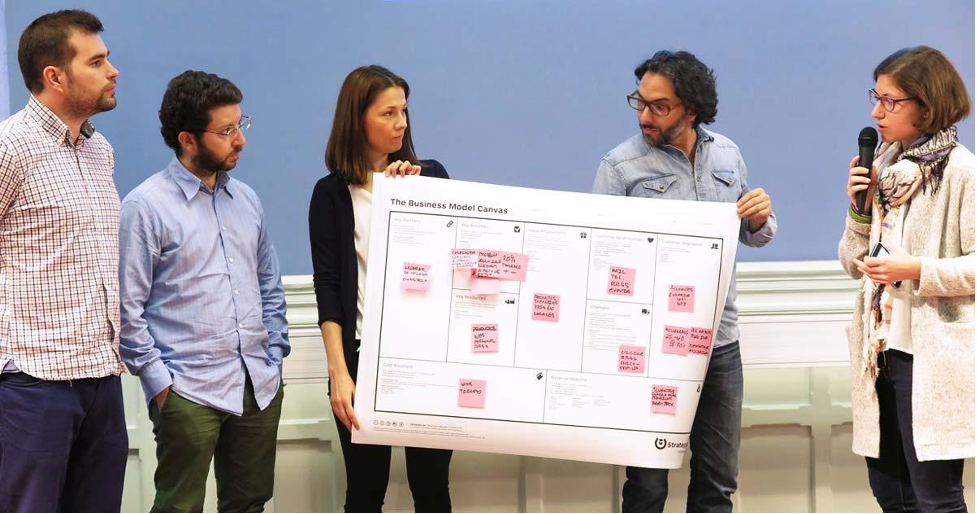Business and technical diagramming involves the visual representation of complex concepts, processes, and strategies. It employs graphical elements to convey information, making it more accessible and understandable for diverse audiences. In the dynamic landscape of business, effective communication is crucial, and diagramming serves as a powerful tool for achieving clarity.
Today, a visual tool plays a pivotal role in enhancing business strategy. In a world inundated with information, visuals cut through the noise and provide a concise way to convey ideas. They stimulate engagement, aid in comprehension, and foster a shared understanding among stakeholders. According to recent findings, a staggering 82% of businesses that incorporate data visualization tools report a substantial improvement in their understanding of company data. Utilizing visual tools in business strategy is akin to speaking a universal language that transcends complexities.
In connection, the Business Model Canvas stands out as a prominent visual tool in the realm of business strategy. Activated by the ingenuity of Alexander Osterwalder, this tool distills crucial facets of a business into a singular, easily digestible framework.With its nine essential building blocks, the canvas offers a structured and visual approach to articulating, analyzing, and refining business models. It has become a go-to instrument for entrepreneurs, innovators, and strategic thinkers alike.
The Need for Visual Representation in Business Strategy
Contents
- The Need for Visual Representation in Business Strategy
- Introduction to Business Model Canvas
- How the Business Model Canvas Facilitates Strategy Development
- Practical Application of the Business Model Canvas
- Tools and Software for Business Model Canvas
- Integration with Technical Diagramming
- Collaborative Features in Business Diagramming Tools
- Best Practices for Business Model Canvas Implementation
- Challenges and Solutions
- Conclusion

A. Communicating Complex Ideas Effectively
At the core of business strategy, effectively communicating complex ideas is a constant challenge. Hence, visual representation serves as a powerful solution, translating convoluted concepts into clear, digestible visuals. This enables stakeholders to grasp intricate details swiftly, fostering a more efficient exchange of ideas and ensuring everyone is on the same page concerning business strategies.
B. Enhancing Understanding and Collaboration
The power of visual representation in business strategy goes beyond simplifying complexity; it catalyzes understanding and collaboration. Visuals provide a shared language that bridges gaps in comprehension among diverse stakeholders. This shared understanding then not only facilitates smoother collaboration but also cultivates a cohesive vision that propels the business forward.
C. Streamlining Decision-Making Processes
In the fast-paced world of business, timely and informed decision-making is critical. Thus, visual representation streamlines this process by presenting relevant data and insights in a visually accessible format. Besides, visual clarity empowers decision-makers, enabling them to rapidly assess information, make more confident and effective strategic decisions, and aim for better business development.
Introduction to Business Model Canvas

A. Definition and Origin of the Business Model Canvas
Alexander Osterwalder envisioned the Business Model Canvas as a dynamic and widely embraced strategic management tool. This innovative framework comprises a visual roadmap with nine key building blocks, empowering entrepreneurs and organizations to actively articulate, analyze, and refine their business strategies with unparalleled clarity and coherence. The canvas’s inherent dynamism encourages proactive engagement, making it the preferred choice for those searching for an interactive and highly effective approach to shape and optimize their business models.
B. Components of the Business Model Canvas
Here are the components of a business model canvas that you should know and understand fully to have flourishing strategic planning and business development.
1. Key Partnerships
This isa critical component of the business model canvas, revolving around the identification and nurturing of vital alliances and collaborations with external entities. Forming strategic partnerships is akin to forging symbiotic relationships that can significantly enhance a company’s capabilities, extend its reach, and bolster overall competitiveness. By aligning with key partners, businesses can access valuable resources, share expertise, and tap into new markets, fostering a mutually beneficial environment that propels growth and innovation. These partnerships serve as a cornerstone for organizations seeking to leverage external strengths to achieve shared objectives and maintain a competitive edge in the market.
2. Key Activities
Key activities are fundamental elements within the business model canvas, involving delineating the primary tasks and operations crucial for the seamless functioning of a business. This encompasses the identification and detailing of core processes that play a direct role in delivering the defined value proposition to customers. Essentially, these activities are the operational heartbeat of the business, representing the crucial steps and functions that contribute to the creation and delivery of the product or service. By outlining these key tasks, organizations gain a comprehensive understanding of the operational intricacies needed to fulfill their value proposition, ensure efficiency, and lay the groundwork for sustainable success. It serves as a strategic roadmap, guiding businesses in optimizing their operational efforts to align with overarching business goals and customer expectations.
3. Value Propositions
This encapsulates the distinct and compelling value that a product or service offers to customers, going beyond mere features to address the fundamental question of why customers should choose it over competing alternatives in the market. A solid value proposition articulates the unique benefits and solutions the offering brings to meet customer needs or solve their problems. Crafting a clear and compelling value proposition is not only essential for differentiation but also acts as one of the business strategies to effectively communicate their relevance and establish a lasting competitive advantage in the marketplace.
4. Customer Segments
In a business model canvas, identifying and understanding the target audience and market segments is a vital exercise. This block delves meticulously into demographics, needs, and preferences, offering insights that guide more effective and targeted strategies. Examining demographics provides a deeper understanding of the diverse characteristics of the customer base, while understanding specific needs allows for tailored products or services. Additionally, exploring customer preferences plays a pivotal role in strategy formation, ensuring that business offerings align seamlessly with customer expectations. In essence, the customer segment block not only identifies but also provides invaluable insights that serve as a strategic compass, guiding businesses toward more effective and targeted approaches in the competitive marketplace.
5. Customer Relationships
In the context of the business model canvas, customer relationships entail defining the nature of interactions and connections established with customers. This includes the strategic spectrum of customer acquisition, retention, and support, all finely tuned to meet and exceed customer expectations. From attracting customers in the initial stages to maintaining and supporting them throughout their journey, this block guides the formulation of tailored strategies that foster enduring and positive relationships.
6. Channels
The channel is a component that intricately outlines the delivery of the business’s value proposition to customers. This entails strategically selecting the most effective distribution and communication channels to reach and engage with the target audience. From identifying optimal delivery mechanisms to ensuring efficient communication pathways, this element serves as a guiding force for businesses, aiding in the formulation of strategies that maximize the impact of their value proposition on the intended audience. It acts as a strategic compass for channel optimization, ensuring that the chosen methods align seamlessly with the business’s overarching goals and effectively resonate with the target market.
7. Key Resources
This requires the precise identification and outlining of critical assets, infrastructure, and intellectual capital crucial for the success of the business. Covering a comprehensive range of both tangible and intangible resources, from physical assets and facilities to intellectual property and expertise, this block guides businesses in recognizing and strategically managing the diverse elements vital to their operations. It serves as a navigational tool for businesses to ensure a robust foundation, integrating tangible and intangible resources harmoniously to drive sustained success and competitive advantage.
8. Cost Structure
Cost structure entails detailing the array of costs and expenses linked to operating the business. This encompasses both fixed and variable costs, requiring a comprehensive understanding of cost drivers and a strategic approach to optimizing resource allocation. By addressing fixed and variable costs while strategically managing resource allocation, organizations can enhance operational efficiency and ensure a financially sustainable framework for their ventures.
9. Revenue Streams
Identifying and categorizing the avenues through which the business generates income involves a nuanced understanding of pricing strategies and revenue models, ensuring smooth alignment with the overall value proposition. This entails recognizing diverse income sources and strategically integrating pricing models. It provides businesses with a strategic approach to optimizing financial inflows. By aligning revenue streams with the overarching value proposition, organizations can foster sustainable income generation, ensuring a resilient and profitable business model.
How the Business Model Canvas Facilitates Strategy Development

A. Visual Representation of Business Elements
1. Creating a Comprehensive Overview
The Business Model Canvas serves as a visual tool that condenses complex business elements into a clear, concise format. This enables stakeholders to gain a comprehensive overview of the entire business model on a single canvas, fostering a holistic understanding.
2. Identifying Interconnections between Components
Through its visual format, the canvas helps identify and illustrate the interconnections between various components of the business model. This visual mapping highlights the relationships and dependencies between different elements, providing valuable insight into how they collectively contribute to the overall strategy.
B. Iterative Strategy Refinement
1. Testing and Adjusting Business Hypotheses
The Business Model Canvas serves as a dynamic tool for iterative strategy refinement, allowing businesses to experiment with and fine-tune their hypotheses. Through visual representations, organizations can assess the viability of different scenarios, enabling data-driven adjustments and enhancements to their strategic approach.
2. Adapting to Market Changes and Feedback
In the ever-evolving business landscape, the Canvas facilitates adaptability by empowering organizations to respond promptly to market changes and feedback. Its iterative framework supports agile adjustments, ensuring businesses can effectively navigate shifting market dynamics and integrate valuable insights to enhance their overall strategy.
Practical Application of the Business Model Canvas

A. Strategy Workshops and Planning Sessions
1. Collaborative Canvas Creation
Strategy workshops leverage the collaborative nature of the business model canvas, bringing stakeholders together for a unified vision. The canvas becomes a shared space where diverse perspectives contribute to the creation of a comprehensive strategic framework. This collaborative approach fosters engagement, aligns team members, and ensures a collective understanding of the business model.
2. Brainstorming and Ideation
In strategy workshops and planning sessions, the business model canvas becomes a catalyst for brainstorming and ideation. By visually mapping key elements, teams can explore innovative ideas and generate creative solutions. Integrating visual tools and automated platforms, such as image editing tools with background remover features, concept boards, color patterns, and typography, enhances the efficiency of brainstorming sessions. These tools provide visual pegs and interactive features, elevating the quality of discussions and promoting a dynamic collaborative environment for strategic innovation.
B. Strategic Analysis and Evaluation
1. Assessing Viability and Feasibility
Moreover, the business model canvas serves as a foundational tool for assessing the viability and feasibility of strategic initiatives. Through a visual representation of key components, organizations can systematically analyze different aspects of their business model. This facilitates informed decision-making by providing a clear overview of potential challenges and opportunities, ensuring that strategies align with the overall goals and feasibility of the business.
2. Identifying Strengths and Weaknesses
In strategic analysis, the Business Model Canvas aids in the identification of strengths and weaknesses within the business model. By visually capturing critical elements, teams can evaluate the inherent strengths that can be leveraged and the weaknesses that need mitigation. This visual approach enhances clarity in identifying areas for improvement, fostering a strategic mindset that seeks to optimize strengths and address weaknesses for overall business enhancement.
Tools and Software for Business Model Canvas

A. Digital Platforms for Collaborative Diagramming
1. Overview of Online Canvas Tools
Online canvas tools revolutionize collaborative diagramming for business models, providing a digital space for teams to collectively work on the business model canvas. Platforms like Miro and Lucidchart offer intuitive interfaces, enabling real-time collaboration and allowing teams to contribute seamlessly. These tools provide features such as drag-and-drop functionality, template libraries, and commenting systems, making collaborative diagramming efficient and accessible across geographical boundaries.
2. Integration with Other Business Applications
Digital platforms for collaborative diagramming seamlessly integrate with other business applications, enhancing workflow efficiency. Tools like Miro and Microsoft Teams integrate with project management and communication tools, ensuring a smooth flow of information. This integration streamlines the collaborative process by allowing teams to connect the Business Model Canvas with project timelines, task lists, and communication channels, creating a centralized hub for strategic planning and execution.
Integration with Technical Diagramming

A. Connecting Business Model Elements with Technical Components
1. Aligning Business Strategies with Technical Infrastructure
Integrating the business model canvas with technical diagramming tools facilitates the strategic alignment of business strategies with technical infrastructure. Tools enable businesses to visually connect business model elements with technical components, creating a unified representation. This efficient way ensures that the technical aspects of a business thoroughly support and reinforce the strategic initiatives outlined in the business model canvas, promoting cohesion between business and technology teams.
2. Enhancing Cross-Functional Collaboration
The integration of business and technical diagramming tools enhances cross-functional collaboration. By connecting the Business Model Canvas with technical components using platforms like Draw.io and Microsoft Visio, teams can collaboratively work on both strategic and technical aspects. This integration fosters a shared understanding between business and technical teams, breaking down silos and promoting a holistic approach to decision-making and problem-solving.
Collaborative Features in Business Diagramming Tools

A. Real-Time Collaboration
1. Simultaneous Editing and Updates
Business diagramming tools with real-time collaboration features enable simultaneous editing and updates. With these business diagramming tools, team members work on the same diagram in real time, fostering dynamic collaboration. This feature ensures that teams can collectively contribute to the business model canvas, providing instant updates and feedback, irrespective of their geographical locations.
2. Remote Team Engagement
Real-time collaboration features in business diagramming tools facilitate engagement for remote teams. Whether team members are working from different offices or diverse locations, these tools ensure seamless collaboration on the Business Model Canvas. This promotes active participation in strategic discussions, fostering a cohesive approach to business planning.
B. Version Control and History Tracking
1. Ensuring Consistency in Business Models
Business diagramming tools with version control and history tracking ensure the consistency of business models. Users can track changes, revert to previous versions, and maintain a reliable record of iterations. This feature is crucial for preserving the integrity of the business Model canvas, providing a clear audit trail, and ensuring that stakeholders access the most up-to-date and consistent information.
2. Facilitating Audits and Revisions
Version control and history tracking in business diagramming tools facilitate audits and revisions. Organizations can track the evolution of the business model canvas over time, supporting regulatory compliance and audits. Additionally, it serves as a valuable resource for continuous improvement, allowing teams to revisit and refine strategies based on historical insights.
Best Practices for Business Model Canvas Implementation

A. Cross-Functional Team Involvement
Cross-functional team involvement is a key best practice for business model canvas implementation. This approach ensures diverse perspectives contribute to the canvas, fostering a comprehensive understanding and alignment of strategic goals. Teams should encourage active participation from members with varied expertise, enhancing the canvas’s richness and relevance to the entire organization.
B. Regular Updates and Reviews
Regular updates and reviews are critical for effective business model canvas implementation. Periodic assessments help teams stay abreast of changes in the business environment and adjust strategies accordingly, ensuring the canvas remains a dynamic and accurate representation. This practice establishes a continuous improvement cycle, allowing organizations to adapt swiftly to evolving market dynamics.
C. Aligning Business Model with Overall Organizational Goals
Aligning the business model canvas with overall organizational goals is a fundamental best practice. This ensures that the strategic initiatives outlined in the canvas are in harmony with the broader objectives of the organization, promoting consistency and coherence in planning. This alignment serves as a strategic compass, guiding decision-making and resource allocation toward overarching organizational priorities.
Challenges and Solutions

A. Overcoming Resistance to Change
Conquering resistance to change is a common challenge in business model canvas implementation. Solutions involve transparent communication, highlighting benefits, and fostering a culture that embraces adaptability, encouraging stakeholders to see change as an opportunity for growth. Additionally, providing training and support helps individuals navigate the transition, fostering a positive mindset toward change.
B. Addressing Complexity in Business Models
Addressing complexity in business models is another challenge. Simplifying language, using visual aids, and breaking down intricate concepts help make the Business Model Canvas more accessible and comprehensible to all stakeholders. Employing workshops and training sessions focused on interpreting and utilizing the canvas effectively enhances the team’s capacity to navigate complex business models with confidence.
C. Ensuring Data Security and Confidentiality
Ensuring data security and confidentiality is a paramount concern. Implementing robust access controls, encryption measures, and adherence to data protection regulations are crucial solutions to safeguard sensitive information within the Business Model Canvas. Rigorous training on data handling practices and periodic security audits further strengthen the organization’s commitment to maintaining a secure and confidential business planning framework.
Conclusion

In summary, the business model canvas stands as a pivotal tool for crafting and communicating strategic vision within organizations. Offering a dynamic visual framework, it empowers cross-functional teams to collaboratively articulate, refine, and align business strategies with overall organizational goals. The canvas not only enhances strategic planning and innovation but also fosters a comprehensive understanding of business elements. By incorporating collaborative features, addressing challenges, and adhering to best practices, organizations can leverage the business model canvas to navigate complexities, foster adaptability, and undoubtedly drive sustained success in today’s business world.


